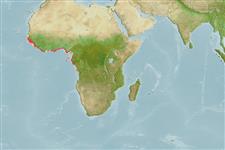>
Clupeiformes (Herrings) >
Dorosomatidae (Gizzard shads and sardinellas)
Etymology: Sardinella: Latin and Greek, sarda = sardine; name related to the island of Sardinia; diminutive (Ref. 45335); rouxi: Named in honor of Charles Roux, director of the 'Centre Océanographique de Pointe-Noire' (Ref. 86940).
Eponymy: Professor Dr Charles Roux (d: 1920) was a French marine zoologist. [...] (Ref. 128868), visit book page.
More on author: Poll.
Environment: milieu / climate zone / depth range / distribution range
Οικολογία
Θαλασσινό(ά); Υφάλμυρο; εύρος βάθους 0 - 50 m (Ref. 188). Tropical; 17°N - 10°S, 18°W - 14°E (Ref. 188)
Atlantic Ocean: Eastern Atlantic Ocean from Senegal southward to Congo, possibly to northern Angola (Ref. 188, 5286, 81269, 81631).
Μέγεθος / Βάρος / Age
Maturity: Lm ? range ? - ? cm
Max length : 16.0 cm SL αρσενικό/απροσδιόριστο; (Ref. 188); common length : 13.0 cm SL αρσενικό/απροσδιόριστο; (Ref. 188)
Ραχιαίες άκανθες (συνολικά) : 0; Μαλακές ραχιαίες ακτίνες (συνολικά) : 16 - 19; Εδρικές άκανθες: 0; Μαλακές εδρικές ακτίνες: 16 - 21. Diagnosis: Body moderately deep, belly fairly sharply keeled (Ref. 188). Lower gillrakers 30-40 (Ref. 188). A black or golden spot behind gill opening; upper part of pectoral fin dusky; caudal fin pale yellow with dusky hind margin (Ref. 188). Sardinella rouxi resembles S. maderensis, which has more gillrakers and a grey caudal fin, its tips almost black (Ref. 188). It is distinguished from small S. aurita by having 1 unbranched and 7 branched pelvic fin rays vs. 1 unbranched and 8 branched in S. aurita, and no black spot on hind part of gill cover (Ref. 188).
Sardinella rouxi is found in inshore waters and along beaches, forming schools (Ref. 188).
Life cycle and mating behavior
Γεννητική Ωρίμανση | Αναπαραγωγή | Γεννοβολία | Αβγά | Γονιμότητα | Προνύμφες
Whitehead, P.J.P., 1985. FAO Species Catalogue. Vol. 7. Clupeoid fishes of the world (suborder Clupeoidei). An annotated and illustrated catalogue of the herrings, sardines, pilchards, sprats, shads, anchovies and wolf-herrings. FAO Fish. Synop. 125(7/1):1-303. Rome: FAO. (Ref. 188)
IUCN Red List Status (Ref. 130435: Version 2024-1)
Threat to humans
Harmless
Human uses
αλιεία: περιορισμένης εμπορικότητας
Εργαλεία
Special reports
Download XML
Διαδικτυακές πηγές
Estimates based on models
Preferred temperature (Ref.
123201): 24.4 - 28, mean 26.8 °C (based on 66 cells).
Phylogenetic diversity index (Ref.
82804): PD
50 = 0.5000 [Uniqueness, from 0.5 = low to 2.0 = high].
Bayesian length-weight: a=0.00851 (0.00399 - 0.01817), b=3.05 (2.88 - 3.22), in cm total length, based on LWR estimates for this Genus-body shape (Ref.
93245).
Τροφικό Επίπεδο (Ref.
69278): 2.9 ±0.3 se; based on size and trophs of closest relatives
Ελαστικότητα (Ref.
120179): Υψηλό, ελάχιστος χρόνος για διπλασιασμό πληθυσμού < 15 μήνες (Preliminary K or Fecundity.).
Fishing Vulnerability (Ref.
59153): Low vulnerability (10 of 100).
